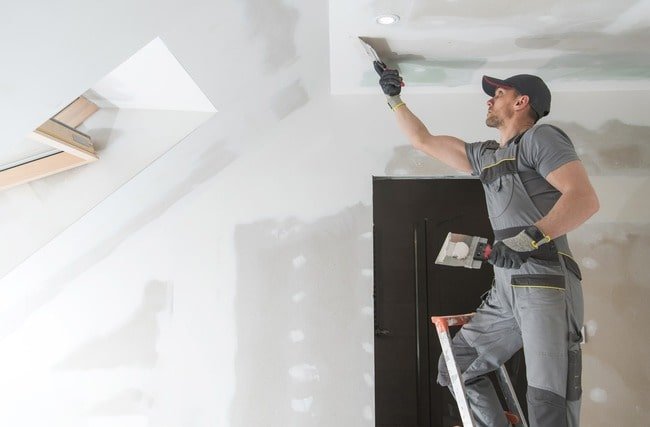What Every Homeowner Should Know About Drywall Repair

Most homes today benefit from drywall construction. In the past, builders used the lath and plaster method, but it came with many drawbacks. For example, lath and plaster construction remains labor intensive, which means the associated costs are higher.
Nevertheless, drywall has its drawbacks. For example, improper installation can lead to the need for drywall repair and the accompanying mess. Drywall is also susceptible to normal wear and tear. Why is it so popular if homeowners know there are issues when this method is used?
The Popularity of Drywall
Drywall comprises gypsum panels covered in paper. Homeowners will find these panels in home improvement stores, with a standard-size sheet measuring four feet by eight feet. The most common thickness is 1/2″. Cutting the panel takes little effort, so the homeowner can measure the size needed and install the drywall.
Repairing lath and plaster takes significantly more time. Long thin strips of wood must be attached to the surface before installation of the walls can proceed. The associated labor costs lead to homeowners looking at alternatives like drywall. Contractors must charge more for plaster work because it is a specialized trade.
Both plaster and drywall remain susceptible to damage. However, the average person can make small drywall repairs. This is not the case when plaster sustains damage. A plasterer must be called in to repair the damage, and someone working in this field can be hard to find. Once the homeowner finds a plasterer, it may be months before they can do the work.
Why Drywall Repairs Might Be Needed?
Drywall is durable, but it is not foolproof. It may need repairs at some point. One of the most common reasons for drywall repair today is improper installation. What problems might this lead to?
Small and Large Holes
The homeowner might find they have small holes in the drywall. A door may blow open and slam into the wall behind it, leaving a hole where the doorknob hit. A child may run through the home and accidentally hit a wall hard enough to leave a hole, or a person might carry something in the house, misjudge the size of the item, and ram it into a wall. These situations can all lead to holes that need to be repaired.
The repair process differs based on the hole size. A person can often repair small holes using joint compound or adhesive backing tape. Apply the compound or tape to the hole and follow up by applying a thin layer of the joint compound. Allow the compound to dry, smooth the surface using sandpaper, and repeat the process two additional times. Finish up by applying drywall tape and priming the area so it can be painted.
Large holes cannot be repaired with joint compound or adhesive tape. Remove the damaged portion of drywall and create smooth edges to hold the replacement piece. When cutting the new drywall, ensure it is properly sized to fit the hole. Place the new drywall in the hole and clean the edges with a joint compound. As with small holes, the joint compound must dry before it can be sanded. Once the area is smooth, repeat the process twice more. Finish up by adding drywall tape and priming the area.
Loose Drywall Tape
Drywall tape can lift or split over time. Often, this problem appears when the tape was not installed properly, but it could also be the result of normal wear and tear. When the tape loosens, cut the damaged section out with a knife. Apply joint compound to the surface and smooth it out. Next, place a new piece of drywall tape over this joint compound and allow the compound to dry. Sand the surface to ensure it is smooth. Once it is, repeat this process two more times before priming the area for paint.
Cracks in the Drywall
A crack may appear in a wall wherever two panels meet. Cracks are also common in joints. Thermal contraction and expansion account for many drywall cracks because the expansion and contraction process put additional stress on the drywall.
As a result, covering the crack with a joint compound won’t work. First, a fiberglass mesh tape is needed over the crack to stop it from expanding. This tape spans the crack and adheres better than paper tape can. Once the mesh tape is in place, follow up with a layer of joint compound and paper tape before priming the repair for paint.
However, before repairing any cracks in the drywall in a home, have the home examined by a structural engineer. Covering up a crack without learning the underlying cause could lead to significant structural damage to the home. If the structural engineer feels the cracks are only cosmetic, the drywall repair can go forward. When there are structural issues, they must be addressed before any work is done to the drywall. Otherwise, the repairs won’t hold.
Drywall Screw and Nail Pops
A person might call for drywall repair when they notice screws or nails popping out of the walls. Improper installation of the drywall panels and screws typically leads to this common issue. The installer either drove the screws too far into the wall or missed the center of the stud when inserting them. However, studs expand and contract when the temperature changes. This expansion and contraction can lead to nails and screws popping.
To fix this problem, the entire nail or screw must be removed from the wall completely. When replacing the nail or screw, never use the original hole. Choose a nearby point and insert the nail or screw there.
Countersink the nail or screw before moving forward. Cover the nail or screw head and drywall tape. Paint over the repair. However, if multiple nails or screws need replacement due to popping, the homeowner might choose to have the entire wall painted instead.
Cracks in Corner Beads
When installing drywall, professionals use steel corner beads. These beads can pop out over time, leading to the need for drywall repair. Begin the repair by removing the drywall that covers this bead.
When the corner bead is exposed, hammer any parts that are no longer flat. In addition, re-screw the bead if the screws or nails are popping. Once the repair has been made, apply drywall tape and joint compound to the bead to prepare it for refinishing.
Water Damage
Water damage remains a concern in any home with drywall. When water enters the home and encounters drywall, mold and mildew may develop if the problem isn’t addressed right away. Any mold and mildew in the home put the family at risk of health issues, so the drywall repair must happen immediately. To address this water damage, the affected portion of drywall must be moved and new drywall installed.
Why Call a Professional for Drywall Repair?
Hiring a professional for drywall repair remains the best option. This individual will complete the repair quickly and efficiently. When doing so, they ensure the value of the home is protected. While a person might repair a hole left by a nail or screw, large holes and water damage should always be addressed by a professional. If a crack is involved, a structural engineer is needed first.
The drywall contractor arrives at the home with the tools and materials needed to complete the repair in one trip. Many people don’t realize what is needed to handle this job. They don’t have a drywall saw, drywall screws, furring strips, and other items that may be needed to do the job right. Purchasing these tools for one-time use makes the cost outrageous. The homeowner can save money by turning to a drywall repair contractor.
The contractor knows which drywall they should use in each part of the home. For example, the drywall used in a bathroom must be resistant to moisture, but the drywall in a bedroom won’t need this feature. The contractor ensures the right material is used for each repair.
They examine the damage and determine what caused it. It is very easy to determine what led to some drywall problems. However, others need to be left to the pros. Drywall cracks are a good example of this. The contractor can examine the crack and determine if a structural engineer must be called in for an assessment.
A homeowner can complete drywall repairs. The question is whether the homeowner should take on this task. Unless they have undergone training to install and repair drywall, the answer is typically no. Filling a hole left in the wall by a nail is something any person can do, so it becomes a judgment call when determining which repair is too big for the average person.
Drywall contractors will take on any job big or small, as they recognize many people don’t feel comfortable handling these tasks. Labor costs remain the highest expense associated with a repair, so call for help with any project. The drywall contractor would rather do the job right the first time than come in behind a homeowner and try to clean up the mess they made when attempting to do the work on their own. Keep this in mind when deciding whether to make the call.







